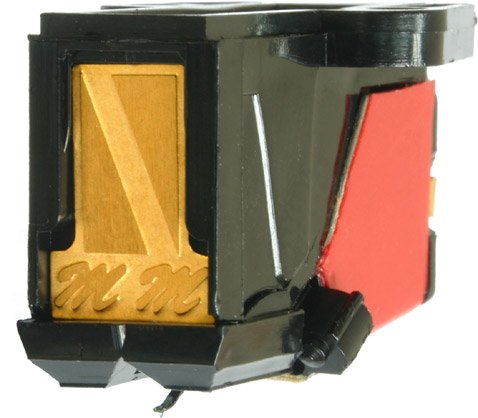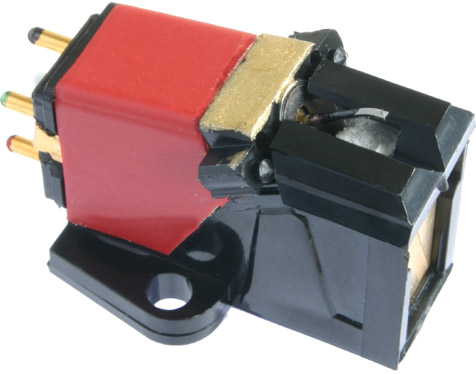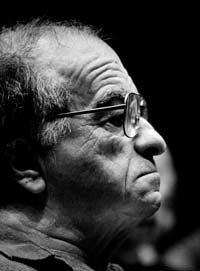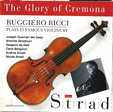The Cartridge Man MusicMaker Classic Phono Cartridge
| The Cartridge Man MusicMaker Classic Phono Cartridge |
| Exclusive! The Premiere Review of Leonard Gregory’s New Masterpiece |
|
|
|
August 2006 |

The Art of Getting to the Art of the Art
Duke Ellington’s famous saying that there are only two types of music – good music and bad music – is partially incomplete. There is also great music. It seems to me that the point of ultra high performance audio systems is to fully reveal the greatest music and to allow complete immersion into it. While audiophiles tend to be extremely aware of sonics, there tends to less consciousness of aesthetic distortion: to my mind a far greater crime.
Though I toiled in the retail audio industry for 25 years before retiring ten years ago and have been writing about music and reviewing audio components since, I remain an audio apostate. I don’t consider myself an audiophile, am neither a component junkie nor an acolyte of The High End. My evaluation of audio components is strictly utilitarian. I view them purely as tools to open the art of music. Unless a component reveals the aesthetic content of any piece or type of music, it must be judged a failure. If one can’t follow all the rhythms of West African Master Drummers; if Vivaldi’s The Four Seasons sounds like elevator music; if one can’t tell the difference between the Bach-playing of Pablo Casals and that of Bach-loving amateur mathematicians; if one doesn’t understand why a whole generation of music lovers define their spiritual and musical lives as being before-and-after hearing John Coltrane and Jimi Hendrix; if the transition in Beethoven’s 5th Symphony from vastation to exultant release doesn’t launch the spirit into the heights, – the system is aesthetically distorting the music.
The greater the artistic quality and complexity of the composition and performance, the greater is the demand on the audio system. I consider the aesthetic education of experiencing the World’s greatest music a prime benefit of our technological age. While the aesthetic behind music from differing cultures can vary it’s also true that there are universal musical patterns and devices used throughout the World’s music. Music truly is a universal language. A sensitive and receptive listener should be able to experience the value of any type of music, provided, of course, that the playback system is fully capable of expressing it.
How directly a component communicates the artistry of the music is a nearly fool-proof criterion for judging the quality of any audio component, system, or musical format. It’s also obvious enough: if you can’t experience the art of the music, what’s the point? A useful tool for judging audio products is to apply the following simple criteria. All any component or system has to do is clearly and unambiguously reproduce WHICH instrument(s) is playing; WHEREit’s playing; WHAT it’s playing, and HOW it’s playing it: leading ultimately to the artistic goal – WHY. This W+W+W+H=Why (more correctly, should = Why) methodological formula enforces a balanced perspective: the WHY of the performance is always paramount in importance. It remains clear that the best components excel at each and every aspect of the formula and that the absolute best open the door to the artistic goals and effects of the music to the fullest.
One of the great joys of audio reviewing, both selfish and altruistic, is discovering audio products that excel at all five prongs of the “Why=W+W+W+H” schema, products that allow a music lover to enter completely into the art of music, no matter how difficult, without the distracting artifacts of the audio reproduction or corruption of the artistic intent. Recent experiences with exceptional products like Harbeth loudspeakers, the Origin Live tonearms and turntables, and the Lavardin integrated amps have been truly transcendent musical revelations: I rate them as masterpieces of the audio arts.
In the world of phono cartridges, The Cartridge Man – Leonard Gregory – is a proven master. His MusicMaker III phono cartridge, mated with The Isolator cartridge/headshell de-coupler, produces such a well-integrated and coherent balance of the five-point W+W+W+H=Why formula that one finds it churlish to attempt to describe the sound, focusing instead on the depth of musical satisfaction so easily and so movingly achieved. Gregory is of that rare species of audio designer who combines an exquisite and refined musical sensitivity and knowledge with long experience and mastery of the technical vagaries of audio design. He balances all the individual demands of sonic reproduction into a musically coherent and communicative whole so successfully that it makes lesser designs seem mere technical exercises. The MusicMaker III cartridge is a well-justified legend, one of the handful of truly great phono cartridges.
When Mr. Gregory informed me that he had created a new phono cartridge – the MusicMaker Classic – I was surprised and greatly intrigued. Since I could find nothing to criticize about the MusicMaker III and found it the purveyor of such complete musical satisfaction, I found it hard to imagine what the new cartridge could do that the MusicMaker III could not.  The Classic retails at $1750 in the USA (the price includes The Isolator) and slots in above the III in the MusicMaker line. Only a slightly reddish hue on the cartridge body differentiates it cosmetically from the gold-colored MM III. The Classic retains the MM III’s variable-reluctance generating principle and healthy 4.0 mV output, its 1.6 gram tracking force, and its front face-vertical visual reference for setting VTA/SRA. The reddish hue results from a new translucent resonance damping material on the external cartridge body. There are interior changes, refinements, and improvements as well. Probably the most notable difference is the Classic’s use of silver coils in its generator. The Classic is unique in non-moving coil cartridges in using silver coils; I can’t recall any other cartridge ever having using them before. The silver is of the highest possible purity and quality available. The Classic was designed for use with the Isolator cartridge/headshell de-coupler in mind. While it is possible to use the Classic without The Isolator, it’s like taking a vow of chastity the morning of one’s wedding day.
The Classic retails at $1750 in the USA (the price includes The Isolator) and slots in above the III in the MusicMaker line. Only a slightly reddish hue on the cartridge body differentiates it cosmetically from the gold-colored MM III. The Classic retains the MM III’s variable-reluctance generating principle and healthy 4.0 mV output, its 1.6 gram tracking force, and its front face-vertical visual reference for setting VTA/SRA. The reddish hue results from a new translucent resonance damping material on the external cartridge body. There are interior changes, refinements, and improvements as well. Probably the most notable difference is the Classic’s use of silver coils in its generator. The Classic is unique in non-moving coil cartridges in using silver coils; I can’t recall any other cartridge ever having using them before. The silver is of the highest possible purity and quality available. The Classic was designed for use with the Isolator cartridge/headshell de-coupler in mind. While it is possible to use the Classic without The Isolator, it’s like taking a vow of chastity the morning of one’s wedding day.
I knew nothing about the Classic’s construction, price, or changes in design when I first auditioned it. I first installed it in my budget reference turntable: the Origin Live Standard Kit with the Origin Live Silver arm. Burn-in from new took about 10-12 hours and was easy on the ears and not at all tedious. It was like listening to a flower bloom. It was sledgehammer obvious that the new MusicMaker Classic is something special and something great. The Classic can be best understood as an ultra high-resolution version of the MusicMaker III. It takes all the wonderful sonic and musical performance aspects of that cartridge, builds on them, and extends them toward their apotheosis. The Classic’s balance of natural timbre, realistic stereophony, and simply spell-binding replication of the What and How of instrumental playing leads to a musically communicative immersion into the art of the music that is unparalleled in my 34-year history with phono cartridges.
Although the cartridge was named for its prowess with Classical music, and incorporates the aesthetic values of the European Classic Era (here applied to engineering and design) of balancing individual characteristics into a unifying over-arching whole, it is clear that one way one improves upon a legend – the MusicMaker III – is to produce a Classic. Leonard Gregory isn’t called The Cartridge Man for nothing.
WHICH and WHERE
The Classic’s way with the timbre of orchestral instruments is superlative: each instrument of the orchestra is immediately identifiable. Running through Britten’s Guide to the Orchestra, Rimsky-Korsakoff’s Capriccio Espagnole, and Vaughan Williams’ Pastoral and Sixth Symphonies revealed a true-to-life timbre unequalled in my experience. Not only was the timbre natural, the specific sonic signature of each instrument was clearly rendered. The French horn’s rearward-pointing bell, forcing its sound to reflect off the recording hall’s rear wall, is well known to classical listeners. The MusicMaker Classic not only captured this subtle sonic signature of the French horn, it managed to keep it in focus even when the French horn was playing with other woodwind instruments. This was true of the entire woodwind family: individual timbre was maintained even when the different instruments were playing notes of similar pitch.

 My ultimate acid test for instrumental timbre is the violin. The violin’s complex harmonic production is fiendishly difficult to get right: it takes only a slight error and it no longer sounds like a violin. Obviously, if you get the violin wrong, classical music is wounded at its heart. The Classic’s performance was again superlative, not only nailing the violin’s timbre, but also allowing perception of individual violins within the orchestra’s First and Second Violin choirs. On Ruggiero Ricci’s The Glory of Cremona, where he plays a number of violins from that great Italian center of violin production, identifying the difference between a Stradivarius and an Amati was obvious. Furthermore, the Classic also revealed the subtle differences between different specimens of an individual luthier’s production. This is high resolution indeed. The sonority of Hugh Bean’s violin in his exquisite performance of Vaughan Williams’ The Lark Ascending was truly and utterly beautiful.
My ultimate acid test for instrumental timbre is the violin. The violin’s complex harmonic production is fiendishly difficult to get right: it takes only a slight error and it no longer sounds like a violin. Obviously, if you get the violin wrong, classical music is wounded at its heart. The Classic’s performance was again superlative, not only nailing the violin’s timbre, but also allowing perception of individual violins within the orchestra’s First and Second Violin choirs. On Ruggiero Ricci’s The Glory of Cremona, where he plays a number of violins from that great Italian center of violin production, identifying the difference between a Stradivarius and an Amati was obvious. Furthermore, the Classic also revealed the subtle differences between different specimens of an individual luthier’s production. This is high resolution indeed. The sonority of Hugh Bean’s violin in his exquisite performance of Vaughan Williams’ The Lark Ascending was truly and utterly beautiful.
![]()
Don’t forget to bookmark us! (CTRL-SHFT-D)
Stereo Times Masthead
Publisher/Founder
Clement Perry
Editor
Dave Thomas
Senior Editors
Frank Alles, Mike Girardi, Russell Lichter, Terry London, Moreno Mitchell, Paul Szabady, Bill Wells, Mike Wright, and Stephen Yan,
Current Contributors
David Abramson, Tim Barrall, Dave Allison, Ron Cook, Lewis Dardick, John Hoffman, Dan Secula, Don Shaulis, Greg Simmons, Eric Teh, Greg Voth, Richard Willie, Ed Van Winkle, Rob Dockery, Richard Doron, and Daveed Turek
Site Management Clement Perry
Ad Designer: Martin Perry





Be the first to comment on: The Cartridge Man MusicMaker Classic Phono Cartridge